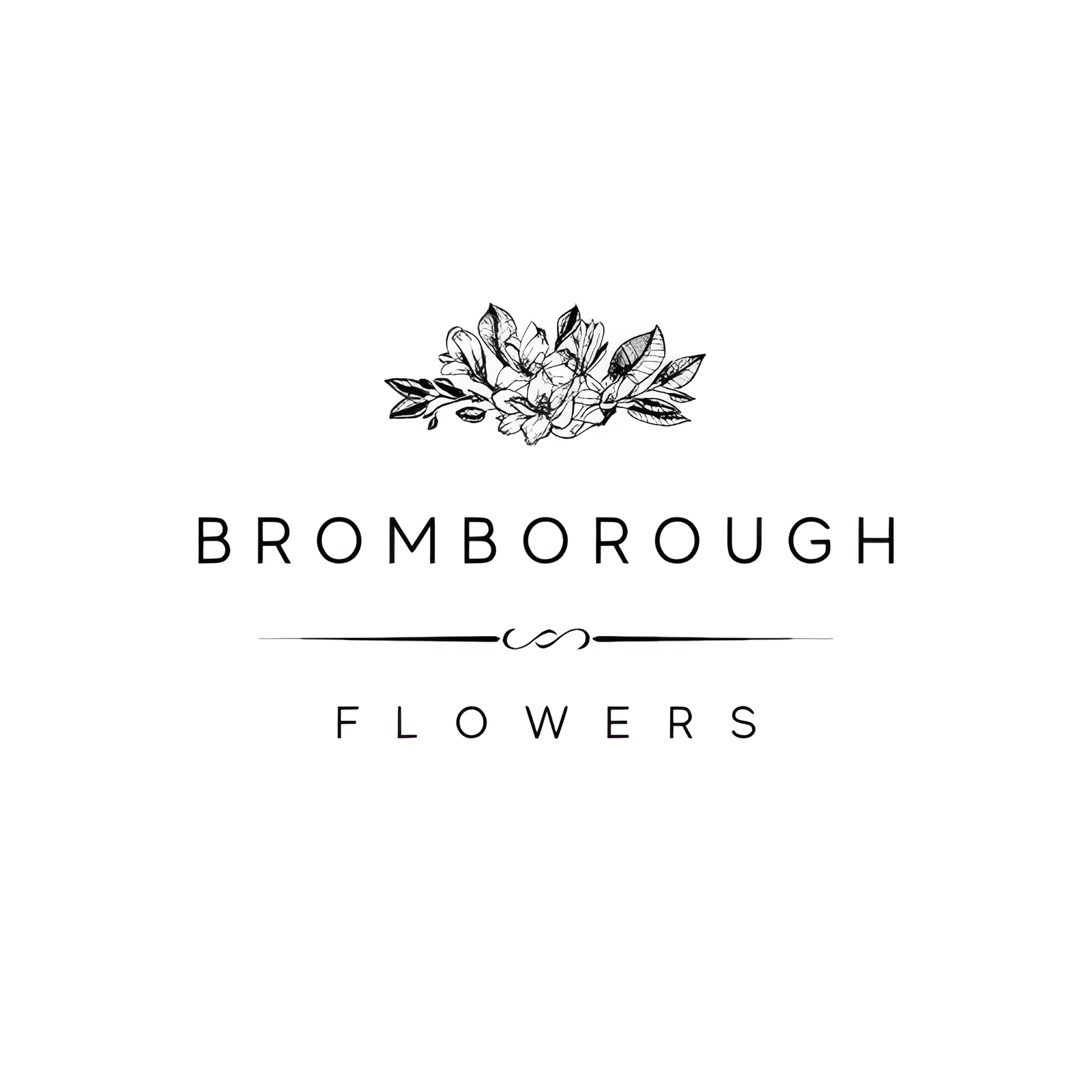Queen Anne's Lace, with its delicate clusters of tiny white flowers, offers a timeless elegance that seamlessly complements any wedding theme. Known for its intricate lace-like appearance and symbolic meanings of beauty, grace, and new beginnings, this versatile flower is available in both classic white and contemporary mauve. Its ability to add a whimsical touch to bouquets and centerpieces has made it a beloved choice among brides and florists alike. But what makes Queen Anne's Lace particularly unique, and how can it be best integrated with other blooms to elevate your wedding decor?
Flower Overview
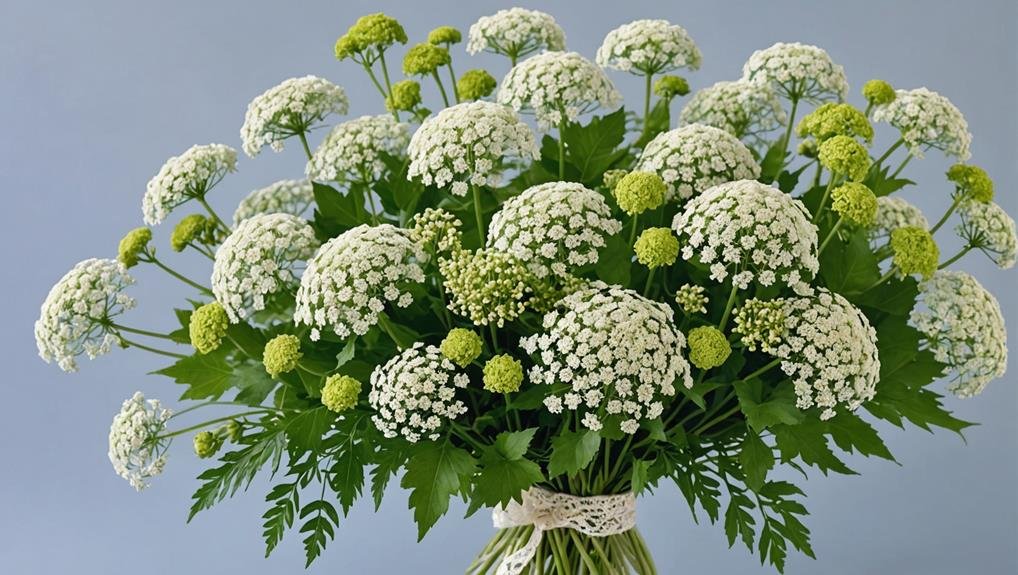
Queen Anne's Lace, also known as Wild Carrot, is a versatile flower characterized by its lacy appearance and delicate texture. This flower belongs to the carrot family and is available in both white and chocolate (mauve) colors. Its intricate and airy structure makes it a popular choice for DIY wedding arrangements, where it often serves as an ideal filler flower.
In the context of romantic arrangements, Queen Anne's Lace adds a touch of elegance and grace. Its ability to blend seamlessly with other blooms allows it to create stunning, elegant bouquets and centerpieces. The flower's delicate texture complements various floral designs, offering a soft, ethereal quality that enhances the overall aesthetic.
Symbolizing beauty, grace, fertility, and new beginnings, Queen Anne's Lace is particularly favored for wedding themes that seek to evoke romance and elegance. With a vase life of 5-7 days, it guarantees that arrangements remain fresh and visually appealing throughout the event.
Typically sold in bunches of 10 stems, this flower provides ample opportunity for creativity in floral design. Queen Anne's Lace is undeniably a versatile and valuable addition to any wedding floral arrangement.
Physical Description
Characterized by their delicate, lacy blooms, the flowers of Queen Anne's Lace typically form clusters that measure 4-5 inches in diameter. These clusters, composed of numerous tiny lacy white flowers, create a visual effect reminiscent of intricate lacework, lending an air of timeless elegance to any arrangement. The blooms possess a subtle, delicate fragrance that adds a gentle sensory dimension to their visual appeal.
Queen Anne's Lace, belonging to the carrot family, shares botanical ties with cumin, fennel, and dill. This flower's intricate structure and airy appearance make it a favored choice among DIY brides looking to add texture and volume to their bridal bouquets. The ethereal quality of the lacy white blooms can symbolize new beginnings, a sentiment that resonates deeply with wedding celebrations.
In wedding arrangements, Queen Anne's Lace can stand alone, showcasing its natural elegance, or be paired with other flowers to enhance their beauty. Its versatile nature allows it to complement a wide range of floral designs, from rustic to sophisticated. The flower's delicate appearance and symbolism of grace and beauty make it a cherished addition to any wedding, embodying the essence of new beginnings and timeless elegance.
Available Colour Varieties
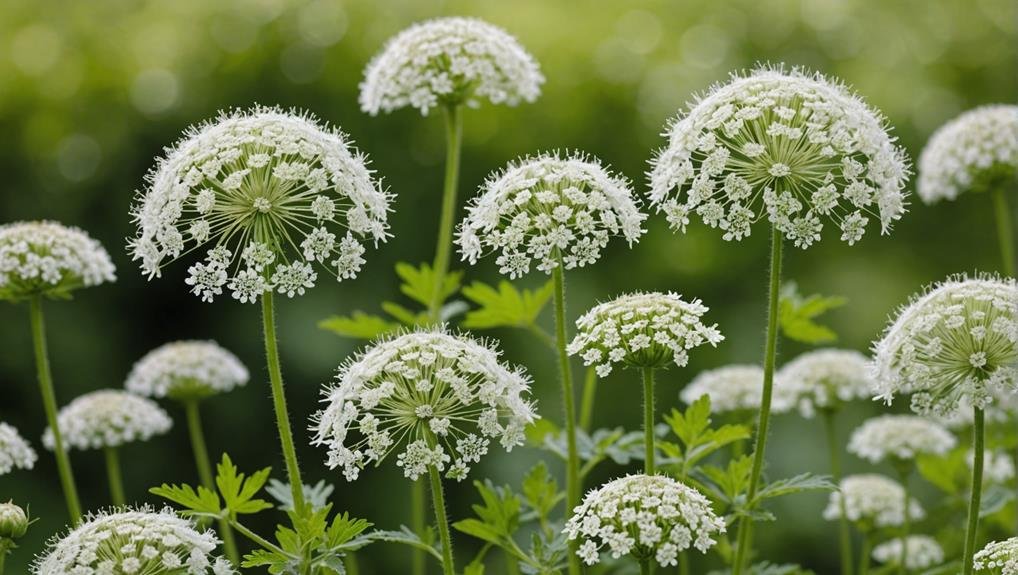
While the classic white variety of Queen Anne's Lace remains a timeless choice for wedding arrangements, there are also unique color options like mauve, known as chocolate Queen Anne's Lace, that offer a modern twist. These color varieties provide additional versatility for floral designers looking to create distinctive and personalized wedding themes.
The white Queen Anne's Lace is celebrated for its pure, neutral tone, making it an ideal filler flower that harmonizes with virtually any color scheme. Its delicate lacy blooms, arranged in intricate clusters, add a textured look that enhances the elegance of bouquets and centerpieces. This classic white option seamlessly blends with both vibrant and pastel arrangements, ensuring a cohesive and sophisticated aesthetic.
On the other hand, the mauve variation, referred to as chocolate Queen Anne's Lace, introduces a contemporary flair to floral designs. This subtle yet striking hue can be used to create a more unique and memorable visual impact. The chocolate Queen Anne's Lace retains the characteristic lacy blooms and clustered formation, offering the same textured look but with a fresh, modern color palette.
Whether opting for the traditional white or the distinctive mauve, Queen Anne's Lace provides versatile and elegant options for any wedding setting.
Latin Name and Taxonomy
The Latin name for Queen Anne's Lace, Daucus carota, places it within the Apiaceae family, highlighting its botanical kinship with both wild and cultivated carrots. This biennial herbaceous plant is scientifically categorized under the genus Daucus, known for its characteristic umbrella-shaped flower clusters.
The taxonomy of Queen Anne's Lace is intricate, encompassing various subspecies and varieties that exhibit distinct traits and habitats.
Queen Anne's Lace, or Daucus carota, shares its Latin name with the cultivated carrot (Daucus carota subsp. sativus) and the wild carrot (Daucus carota subsp. carota). This relationship is not merely nominal; it underscores a deep genetic connection within the Apiaceae family, which also includes other familiar plants like parsley, celery, and fennel.
The biennial nature of this herbaceous plant means it completes its life cycle over two years, with the first year dedicated to vegetative growth and the second to flowering and seed production.
Understanding the taxonomy of Queen Anne's Lace is essential for horticulturists and florists alike, as it aids in identifying its various forms and appreciating its diverse botanical characteristics. This knowledge enhances the ability to select the appropriate variety for different floral arrangements and wedding themes.
Geographical Origins
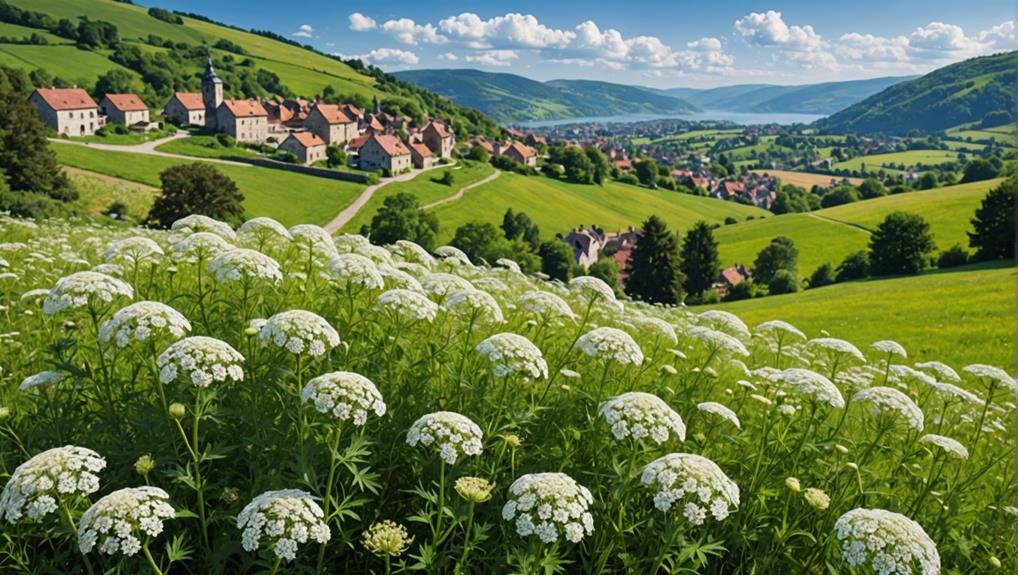
Native to Europe and Southwest Asia, Queen Anne's Lace has adapted to various environments, making it a versatile plant in both its natural and cultivated forms. Known botanically as Daucus carota, this plant, commonly referred to as Wild Carrot, has found its way across continents and naturalized in North America. Its ability to thrive in well-drained soil and full sun conditions has contributed to its widespread distribution.
Queen Anne's Lace is a hardy plant that self-seeds, allowing it to spread easily in diverse climates. This adaptability has led to its presence in fields, meadows, and along roadsides across its geographical origins and beyond. The flower is noted for its delicate, lace-like appearance and can be found in an array of colors, including white, pink, and purple, adding to its appeal in floral arrangements.
Below is a table summarizing its geographical origins and spread:
| Region | Characteristics |
|---|---|
| Europe | Indigenous, thrives in well-drained soil |
| Southwest Asia | Indigenous, adapts to full sun conditions |
| North America | Naturalized, grows in fields and meadows |
The self-seeding nature of Queen Anne's Lace guarantees its continued proliferation, making it an enduring presence in both wild and cultivated landscapes.
Season Availability
Queen Anne's Lace flowers are generally available from late spring through early autumn, providing an extended season of vibrant blooms. Typically, these delicate flowers grace gardens and floral arrangements from May to October, thriving during the warm months of summer and early fall. Their seasonal presence guarantees that brides and event planners have access to fresh flowers that enhance the beauty of any occasion.
When planning to incorporate Queen Anne's Lace into your wedding or event floral arrangements, it's important to take the season into account. The availability may vary depending on your location and local climate conditions. For instance, in regions with milder climates, these flowers might be available slightly earlier or later than in areas with more extreme weather patterns.
The warm months of summer and early fall are ideal for sourcing Queen Anne's Lace, as the flowers are at their peak during this period. This guarantees that you can enjoy the freshest and most vibrant blooms for your special day.
To make sure of their availability, it's advisable to consult with local florists and plan accordingly, as they can provide insights specific to your area and assist in securing these beautiful flowers for your event.
Growing Conditions

Ideal growing conditions for Queen Anne's Lace include full sun to partial shade and well-drained soil with moderate moisture levels. This adaptability makes Queen Anne's Lace a versatile addition to various garden settings.
While the plant thrives in well-drained soil, it is also drought-tolerant once established, which means it can endure periods of low rainfall without significant harm to its health.
Queen Anne's Lace is notable for being either a biennial or perennial plant, depending on its variety. In its first year, it typically forms a rosette of leaves, followed by flowering in its second year. Some varieties may persist longer, offering extended visual appeal and ecological advantages.
Gardeners will appreciate that Queen Anne's Lace attracts a range of pollinators, including bees and butterflies. These pollinators are essential for maintaining the health and biodiversity of the garden ecosystem.
Cultural Significance
Often celebrated for its delicate beauty, Queen Anne's Lace carries deep cultural significance that spans various historical periods and traditions. Named after Queen Anne of England, a renowned lace maker, the flower's intricate design highlights its historical significance.
In various cultures, Queen Anne's Lace has been associated with love potions, craftsmanship, and human vulnerability, underscoring its symbolism and cultural resonance.
Historically, Queen Anne's Lace has played a role in Midsummer celebrations, where it was used in herbal medicine and fertility rituals. These traditions underscore the flower's long-standing cultural significance, connecting it to themes of protection and sanctuary.
Its delicate structure and appearance symbolize the complexity of love, making it a poignant representation of affection and intimate bonds.
The cultural significance of Queen Anne's Lace is further enriched by its use in rituals that emphasize human connections and emotional depth. This historical backdrop adds layers of meaning to the flower, making it not just a beautiful addition to various occasions but also a symbol rich in heritage and sentiment.
Its enduring presence in cultural practices highlights its deep-rooted significance and timeless appeal.
Typical Use in Weddings
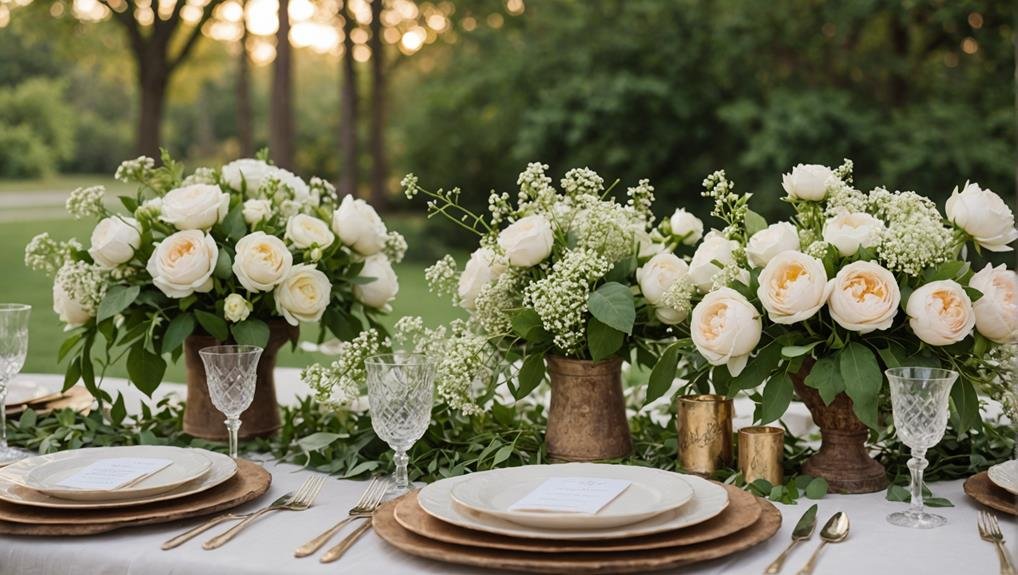
Integrating its rich cultural significance, Queen Anne's Lace is prominently featured in weddings due to its whimsical and romantic appeal. Its lacy white blooms add a delicate and enchanting touch to various wedding elements, making it a preferred choice for many bridal arrangements.
Due to its versatility and lace-like appearance, Queen Anne's Lace is often used to complement a wide range of flowers and greenery in bouquets, centerpieces, boutonnieres, corsages, and aisle decorations.
One of the reasons Queen Anne's Lace is favored in weddings is its symbolism of grace, beauty, fertility, new beginnings, and good luck. These meanings align perfectly with the themes of love and new chapters inherent in weddings. The flower's ethereal quality and affordability make it particularly popular among DIY brides who aim to create beautiful, cohesive wedding decor without overspending.
When incorporating Queen Anne's Lace into wedding arrangements, it often serves as an elegant filler flower, adding texture and fullness. Many brides and wedding planners opt to purchase wholesale Queen Anne's Lace to make certain they have an ample supply for various uses. This approach is both cost-effective and guarantees consistency in the floral design.
Alternative Flower Types
For couples seeking alternative flower types to Queen Anne's Lace, there are several equally enchanting options to explore for wedding arrangements. These alternatives can provide similar texture and natural beauty, making them perfect for creating stunning and eco-friendly wedding flowers.
Baby's Breath (Gypsophila): This classic filler flower is known for its delicate, cloud-like clusters, adding a soft touch to any bouquet or floral arch. Its simplicity complements a variety of floral designs, from rustic to elegant.
Astilbe: With its feathery plumes, Astilbe offers a unique texture that can enhance the aesthetic of wedding flowers. Available in a range of colors, it serves as a versatile flower for both bouquets and centerpieces.
Waxflower: This small, hardy bloom is a popular DIY flower choice. Waxflower's tiny, star-shaped petals add a touch of whimsy and natural beauty to any arrangement, making it perfect for eco-friendly weddings.
Each of these alternatives to Queen Anne's Lace can be used to create beautiful, cohesive wedding decor. Whether incorporated into a floral arch or as part of a bridal bouquet, these texture flowers provide endless possibilities for couples aiming for a personalized and memorable celebration.
